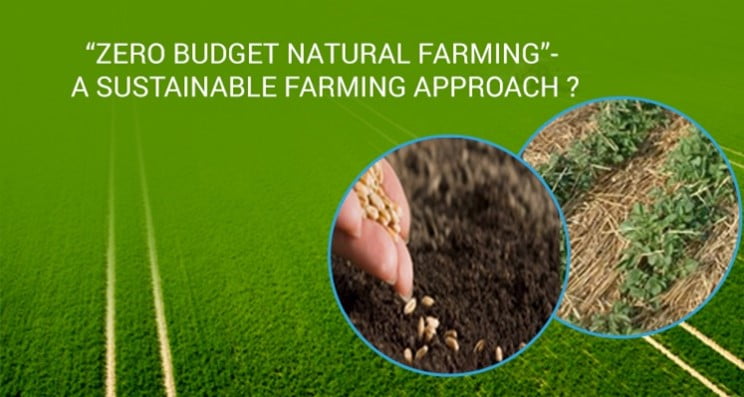Economics
Context: There is an urgent need to scale up alternative approaches of farming since, the negative impact of the Green Revolution has been heightened further by the pandemic. Natural farming needs to be practised on scale and in areas that do not impact food security. However, the natural farming in India has persistent uncertainties, making it an emotive issue.
About Natural Farming:

- It was introduced by Masanobu Fukuoka, a Japanese farmer and philosopher, in his 1975 book The One-Straw Revolution.
- Natural farming is a method of chemical-free agriculture drawing from traditional Indian practices.
- It is a unique model that relies on Agro-ecology aiming to bring down the cost of production and boost the return to a sustainable level.
Features of Natural Farming:
- Chemical Free: Natural farming refers to the type of agriculture in which the use of chemicals like pesticides, fertilisers, growth regulators, food additives, genetically modified organisms are entirely shunned.
- Use of Alternatives Systems: In place of chemical based inputs, natural farming utilises methods like crop rotation, use of green manures and compost, biological pest control and mechanical cultivation.
- Additional Practices: Natural farming systems can be complemented with practices like crop rotation (planting different crops sequentially), mulching (see inset), intercropping (planting different crops simultaneously in a field) and seed soaking with liquid manure, to increase the yields in a field.
Impact of Green Revolution on Agriculture:
- India’s Green Revolution in the 1960s was based on high-yielding varieties, irrigation and fertilisers.
- The Green Revolution transformed India from a ‘ship-to-mouth’ existence, through the American PL-480 food grants, to a food-secure, Agri-exporting nation.
- India moved into a different realm and created a huge stability and resilience.
- Hence, it is time to look back at the past and prevailing successful examples and stop being diffident.
Significance of Natural Farming:
- Soil Health: Natural farming leads to better soil health as it does not deplete the macro-nutrients (nitrogen, phosphorus and potassium) and micro-nutrients (iron, manganese, zinc and copper), organic carbon as well as rhizosphere microbiome in the soil, unlike the conventional chemical-based practices.
- Environment: Natural farming leads to lesser carbon emissions, in addition to promoting carbon sequestration. It also promotes soil respiration, growth of beneficial organisms like earthworms, soil enzymes and microbial biomass increase.
- Crop Yield: Natural farming is more productive as compared to chemical-based farming.
- Reduction in the Costs: As the inputs are produced by the farmers on the farm itself, the costs would be decreased substantially.
- Water-use efficiency: Use of natural methods of farming leads to more efficient use of soil moisture, leading to an increase in the levels of water table, prevents over-extraction of groundwater and promotes aquifer recharge.
- Food Quality: It promotes the growth of nutrient content and improves the physical attributes of vegetables like tomato, cabbage and cowpea, fetching better prices in the market.
- Income and Livelihood: This approach not only leads to minimise cost of cultivation (as inputs are produced on-field), it also fetches a premium price for the produce.
Challenges to Natural Farming:
- Yields drop: India’s first organic state, Sikkim, has started seeing decline in its yields after a few years.
- Conviction among Policy Makers: As of now, policy makers fear for the food security of the nation and are non-committal on any major changes in the agriculture sector.
- Resistance by the Chemical inputs-based industry: The chemical-based farming has a strong backing in the form of multi-million dollar agro-chemical industry, which has fought tooth and nail to sustain the application of chemicals in agriculture.
- Lack of Consensus among the Scientific community: Though agreeing to its health and environmental benefits, the scientific community is divided on the impact of natural agriculture on crop yields.
Government Initiatives to promote Natural farming:
- Policy on Organic Farming 2005: The policy was launched in 2005 under the aegis of the Ministry of Agriculture and Farmers’ Welfare.
- It seeks to promote organic farming and conserve bio-resources, resulting in strengthening of rural economy, promotion of value addition, sustaining soil fertility and accelerating growth of agri-businesses in the country.
- Paramparagat Krishi Vikas Yojana: It is a sub-component of Soil Health Management under National Mission of Sustainable Agriculture.
- It primarily aims at developing healthy agriculture models through a mix of traditional wisdom and modern scientific advancements. It also seeks to promote soil fertility build-up, resource conservation and climate change mitigation
- Mass movement: Recently, the PM of India has made an appeal to the farmers of the nation, to make organic farming a mass movement in the country.
Suggestive measures to scale up Natural farming:
- Promoting in tribal and rain fed areas: Rain-fed and tribal areas which are still not Agri-input intensive, producing nutri-cereals, pulses and oilseeds are the ideal places to begin with.
- Productivity of these areas must be stabilised and improvised as nearly 55 per cent of the net sown area is rain-fed and 61 per cent of our farmers inhabit these areas.
- Promoting natural farming in rainfed areas beyond the Gangetic basin: Home to half of India’s farmers, rainfed regions use only a third of the fertilisers per hectare compared to the areas where irrigation is prevalent.
- The farmers stand to gain as the current crop yields in these areas are low.
- Securing insurance of organic farmers: Enable automatic enrolment of farmers transitioning to chemical-free farming into the government’s crop insurance scheme, PM Fasal Bima Yojana (PMFBY).
- Any transition in agriculture: Crop diversification, change in farming practices adds to the farmer’s risk. Covering such risks could enhance the appetite of the farmers to embark on the transition.
- Promote microenterprises that produce inputs for chemical-free agriculture: Lack of readily available natural inputs acts as a barrier for farmers. For this setting up of village-level input preparation and sales shops can be explored.
- Leverage NGOs and champion farmers: For promoting and practising sustainable agriculture across the country, at least five million farmers are already practising some form of sustainable agriculture and hundreds of NGOs are involved in promoting them.
Source: The Hindu
















